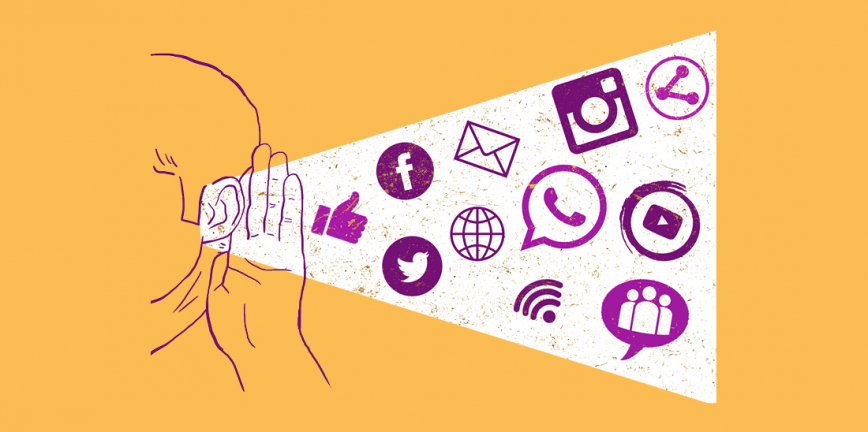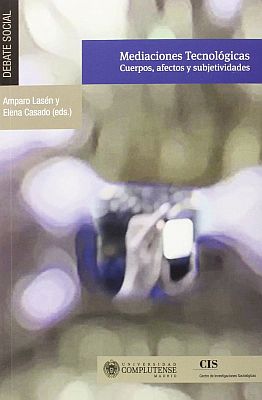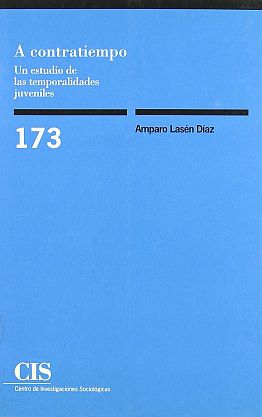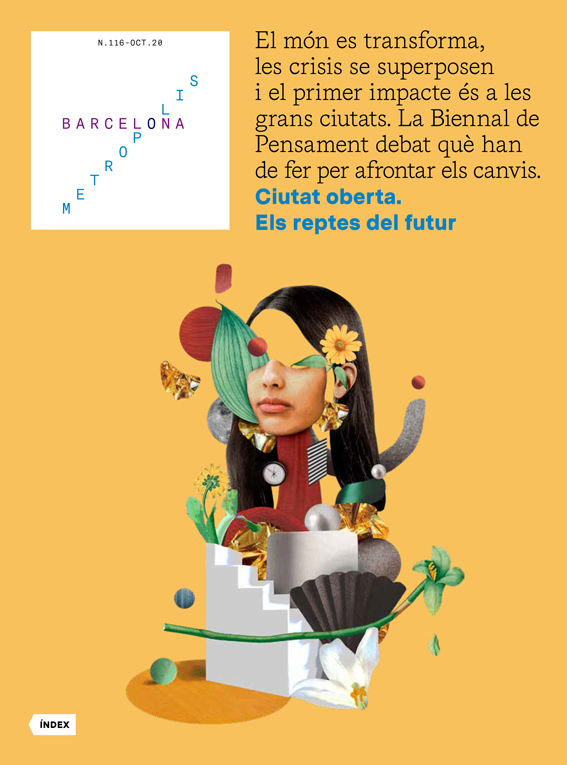Listening to the digital ordinary
Open city. The challenges of the future
- Dossier
- Oct 20
- 10 mins

If the presents and futures of our everyday urban life are entwined and unravelled in digital entanglements, knowing how to listen to them is crucial. But the right to be heard also implies the right to remain silent, to disconnect and to protect ourselves from the algorithms of oppression and surveillance that perpetuate the rules of exclusion.
Our daily lives are caught up today in mobile devices, apps, social networks and other digital platforms, both in terms of their banalities, vulgarities, frivolities, pains, emotions and intensities – in which the extraordinary and the worrying also surface –, as well as the social orders and the rules concerning what is right that is done and undone in everyday life. These entanglements of the digital ordinary also contribute to making and unmaking the city and the urban, in a collective, networked, dynamic, conflictive and on-going construction that involves different entities, human and non-human. Therefore, the city and digital uses and practices are the outcome of shared and distributed agencies, of choreographies and frictions, between different people, groups, entities, bodies and materialities.
Listening to the urban, in addition to being digitally mediated, calls for listening to sounds and silences, the presence and absence of everyday digital entanglements. Listening is attention on tenterhooks: between objects and subjects, between contexts and contents, and between times (the present, history and the memory of past listening, and the future that is shaped in the hopes and expectations resting on that memory). Listening leads to intensification and vigilance, curiosity or restlessness. Dealing with and leaning towards a possible meaning that is not immediately accessible. Entering into a spatiality (in this case urban and digital) that sweeps over us, both inside and out, part of a vibration, of a resonance. This is also the position of investigating and inhabiting the city. Listening is therefore revealed as a deeply political action linked to power relations, as well as to the organisation and experiences of what is public.
The pedagogy of transparency also adjusts our relations with public institutions (this is not new) and with digital companies.
Digital inscriptions and changes in attention systems
The digital influences and shapes how we make ourselves public, how we make something public and how we make what is public, in a growing digital inscription of spaces, practices, bodies, relationships, ideas, conflicts, debates, initiatives, desires, subjectivities, transactions and mobilisations, in the form of images, sounds and texts, as well as data and metadata, recorded and combined by algorithms, shared and stored on devices, platforms and servers. These digital inscriptions generate two major changes in our everyday urban lives and their attention systems:
- The materialisation and inscription of what used to be ephemeral and volatile, and of what is ignored in its usual banality, off the radar of our consciousness.
- The consequent rise in the potential and capacity of reflexivity and vigilance of these inscriptions.
This broadening of the scope of what can be seen, heard, addressed and known increases the odds of (inter)personal, collective, institutional, commercial and automated surveillance and control. The pedagogies of transparency intensify; for example, in the digital mediations of intimacy, where it is brought to bear with the cruel optimism – described by Laurent Berlant – of family relationships, of couples and of sexuality, foci of the expectations and desires of achieving the good life, but they do not stop giving us a bad life. Well, the cruelty of that arises in the disregard for the old feminist saying that the personal is political, inevitably affected by conflicts, inequalities and power relations. The pedagogy of transparency also adjusts our relations with public institutions (this is not new) and with digital companies that market and exploit our inscriptions, turned into data whose transparency contrasts with the opacity of digital infrastructures and regulations, of algorithms, of the selection of what we see and hear, what our data comes from and how they are used.
Fake news, disinformation campaigns and media and digital intoxication, harassment and trolling, which are often presented as exercises in freedom and the freedom of speech and opinion, are undemocratic acts because they do not respect or fulfil the right to listen.
Those changes in the inscription and attention systems also create possibilities and opportunities for disagreements, conflicts, misunderstandings (intrinsic to any form of communication) and woes to arise, and for them to be visible and audible too. Disagreements, controversies, conflicting emotions that disrupt ordinary rules, expectations, behaviours and perceptions. In combining the constitution of spaces and control and surveillance devices – with a potential to upset orders, by accommodating, listening and possibly lending attention to a plurality of bodies and voices, as well as those in subordinate, excluded and vulnerable positions – the ambivalence of the digital.is a feature it shares with the city (surveillance and control device, and different living space and controversy), as well as with democracy.
Both aspects of the digital are also related to the reinforcement and questioning of the social stratification of attention, based on gender, class, race, nationality, (dis)abilities..., in which the democratic requirement of being equally audible clashes with growing inequalities and the logics of exclusion. Fake news, disinformation campaigns and media and digital intoxication, harassment and trolling, which are often presented as exercises in freedom and the freedom of speech and opinion, are undemocratic acts because they do not respect or fulfil the right to listen (Taylor, 2020). The lack of attention and the explicit obstruction of listening to the voices, presences, images and bodies of those whom we do not recognise or respect – because they do not match normative, racial, national, sexual, ableist, cisgender expectations... – translate into rejection, hostility, disgust and damage, both in networks and in the streets, and represent a severe limitation and crisis for democracy. Faced with this, silencing, blocking, switching off, getting distracted, neglecting, removing the sound of the transmission when certain subjects appear on the screens with damaging voices and statements, are actions under the ethical management of digital listening, as well as of protection and care, and sometimes of survival.
 © Raquel Marín
© Raquel MarínThe right to listen entails the right to silence, because for listening and attention to be possible, rhythms and alternations with silence, inattention, relaxation and distraction are required. The hypermediated urban and digital contexts, of constant commerce and surveillance, conflict with an ethic of listening that needs to interrupt and set the pace of attention, activity and tension, both in digital and urban spaces, in order to also free ourselves from the flustering and draining nature of constant demands for attention. How can we set those rhythms, as well as the conditions of that equality in listening and in the ways we inhabit and move around the city and the digital world? Who makes the effort to listen to whom? What are the expectations of being or not being listened to? What power and might mobilise those who speak? And what is the power of listening? What are the effects (and the feelings) of not being listened to, of the absence of response and dialogue, of influence and participation in the conversation, of actions and mediations that indicate that we are being listened to and taken care of? And how does not being listened to in this digital ordinary affect us, while we are watched, measured and recorded by the algorithms of oppression, in the words of Safiya Noble, which reinforce and perpetuate standards and criteria of stratification and exclusion?
Instead of the technocratic corporate insistence on what is smart, which refers to the cruel optimism (the promise of a good life that never ceases to give us a bad life) it may be useful to address the idiotic dimension of digital culture, humour, parodies and collective digital creativity.
Urban futures of the digital ordinary
Digital entanglements shape presents and futures with their inevitable uncertainty, especially if you are on the dodgy side of inequality. Modern stories of progress call for technological solutionism to control uncertainty, as in the example of the smart city – which does not listen to the entanglements, tensions and conflicting interests that shape both the urban and the digital –, unlike dystopias and predictions of catastrophic futures commonly also associated with technology that, together with the ambivalent experiences of urban life and its intense public sociability, have always fostered imaginaries of contagion, illness and death. Its latest version would be the denunciations of the alleged links between the pandemic and 5G and attacks on towers. Another example is the fear of technological dehumanisation, a partial and worrying recognition of the entanglements of the human with the non-human, of the agencies shared with materialities and the diverse bodies with which we coexist. That our actions, behaviour and subjectivities take place in a network and entangled with objects and other beings does not arise with the digital; it is part of our ontological interdependence, to which the modern ideologies of the autonomous being have turned a deaf ear for centuries, with disastrous consequences. Instead of the technocratic corporate insistence on what is smart, which refers to the cruel optimism (the promise of a good life that never ceases to give us a bad life) of that pharmakon solutionism, where the remedy is poison (of surveillance, control, automation biases, programmed obsolescence, unsustainable energy waste, etc.), it may be useful to address the idiotic dimension of digital culture analysed by Olga Goriunova, both of young people and adults, displayed in humour, parodies, the absurd, in the collective digital creativity of memes, (re)tweets, videos, tutorials and GIFs, in the idiotic force of the viral, of the fleeting contents of stories, of networks such as Snapchat or TikTok, in the success and attraction of shared and digitally mediated choreographies, where body listening, dance, shared agency with digital devices and spaces, also generate new uses and meanings for individual and collective action and performance repertoires, both in the intimate spaces of our homes and in urban public spaces featured in these recordings.
If the presents and futures of our everyday urban life are entwined and unravelled in digital entanglements, it is crucial to listen to these spaces, as well as to address the rules and disciplines that facilitate or hinder listening and attention that come about and are shaped therein. And also to listen to the deployment of responsibilities, of capacities for response (as a fundamental feature of communal living, as defined by Audre Lorde), not as a set of similarities but as a community of differences that encourages creative ways of overcoming oppressive conditions, in the interdependence of recognitions, without calling for consensus or foregoing one's own peculiarities and oddities (queerness); a community where difference can forge connections and provide sufficient assurance to be able to take action and step in.
References
Berlant, L., Cruel Optimism. Duke University Press, Durham, 2011. (Partial translation in “Cruel Optimism”, in Debate Feminista, 45, 2012, pp. 105-136. http://debatefeminista.cieg.unam.mx/df_ojs/index.php/debate_feminista/article/view/899/800).
Goriunova, O., “New Media Idiocy”, in Convergence, 19 (2), 2013, pp. 223-235.
Lasén, A., “Lo ordinario digital: digitalización de la vida cotidiana como forma de trabajo”, in Cuadernos de Relaciones Laborales, 37 (2), 2019, pp. 313-330. https://revistas.ucm.es/index.php/CRLA/article/view/66040.
Lorde, A., La hermana, la extranjera. Artículos y conferencias. Traficantes de Sueños, Madrid, 2002.
Noble, S., Algorithms of Oppression. How Search Engines Reinforce Racism. New York University Press, New York, 2018.
Pardo, C., “Capitalismo, sonidos y procesos de subjetivación en la ciudad contemporánea” in Panambí. Revista de investigaciones artísticas, 4, 2007, pp. 111-124.
Taylor, A., “The Right to Listen”, in The New Yorker, 27 January 2020. https://www.newyorker.com/news/the-future-of-democracy/the-right-to-listen
Recommended publications
 Mediciones tecnológicas: cuerpos, afectos y subjetividadesElena Casado and Amparo Lasén (ed.). CIS, 2014
Mediciones tecnológicas: cuerpos, afectos y subjetividadesElena Casado and Amparo Lasén (ed.). CIS, 2014 Jóvenes y comunicación. La impronta de lo virtualFAD, 2014
Jóvenes y comunicación. La impronta de lo virtualFAD, 2014 A contratiempo. Un estudio de las temporalidades juvenilesAmparo Lasén. CIS, 2000
A contratiempo. Un estudio de las temporalidades juvenilesAmparo Lasén. CIS, 2000
The newsletter
Subscribe to our newsletter to keep up to date with Barcelona Metròpolis' new developments




